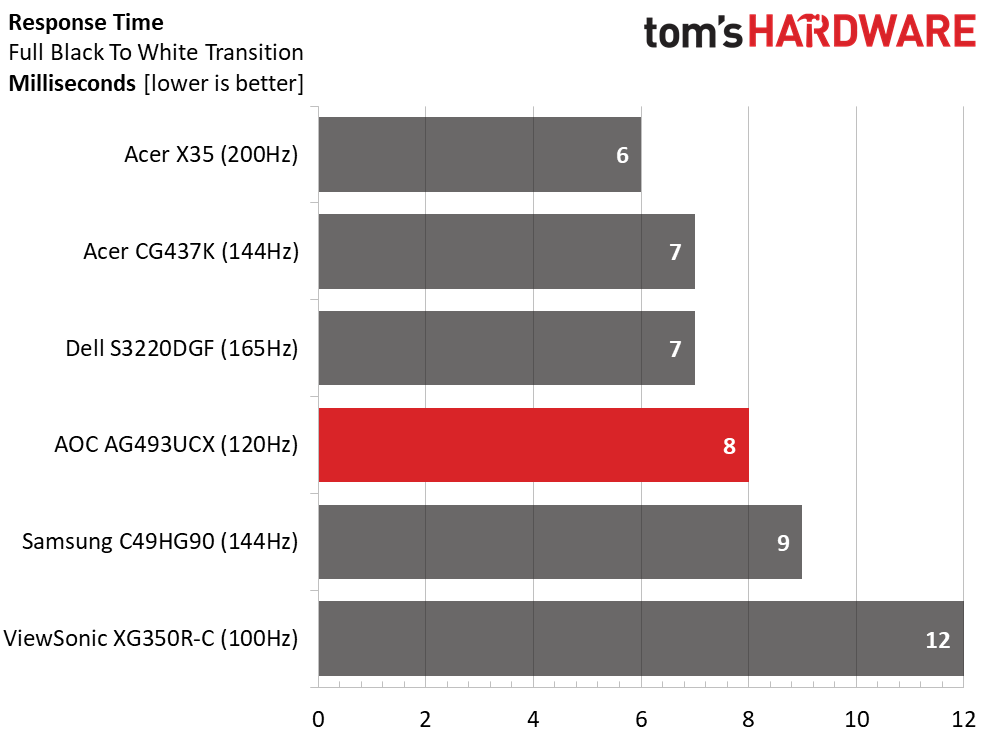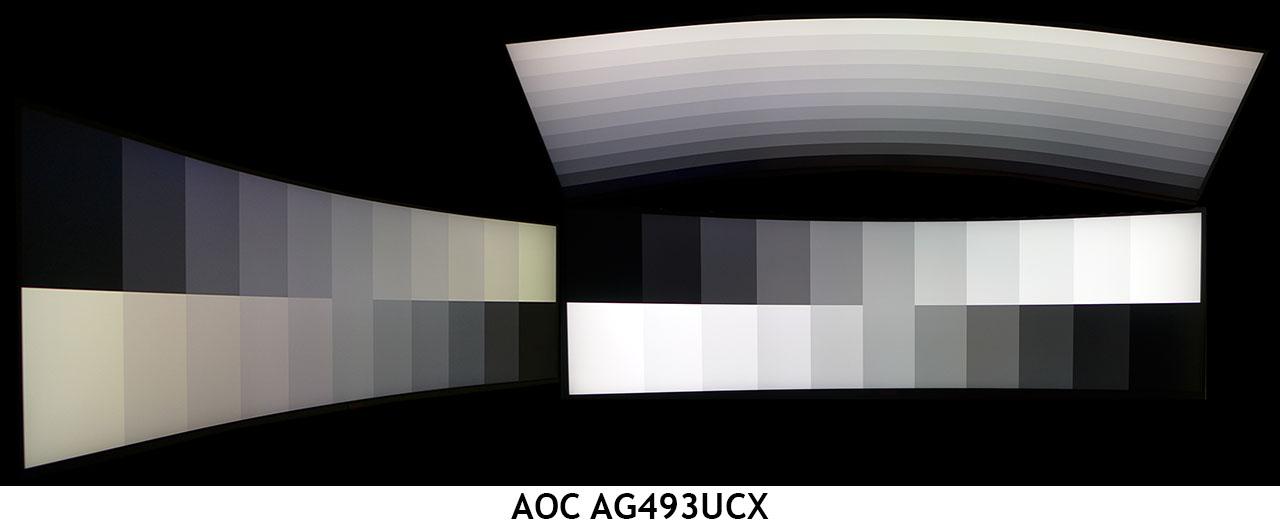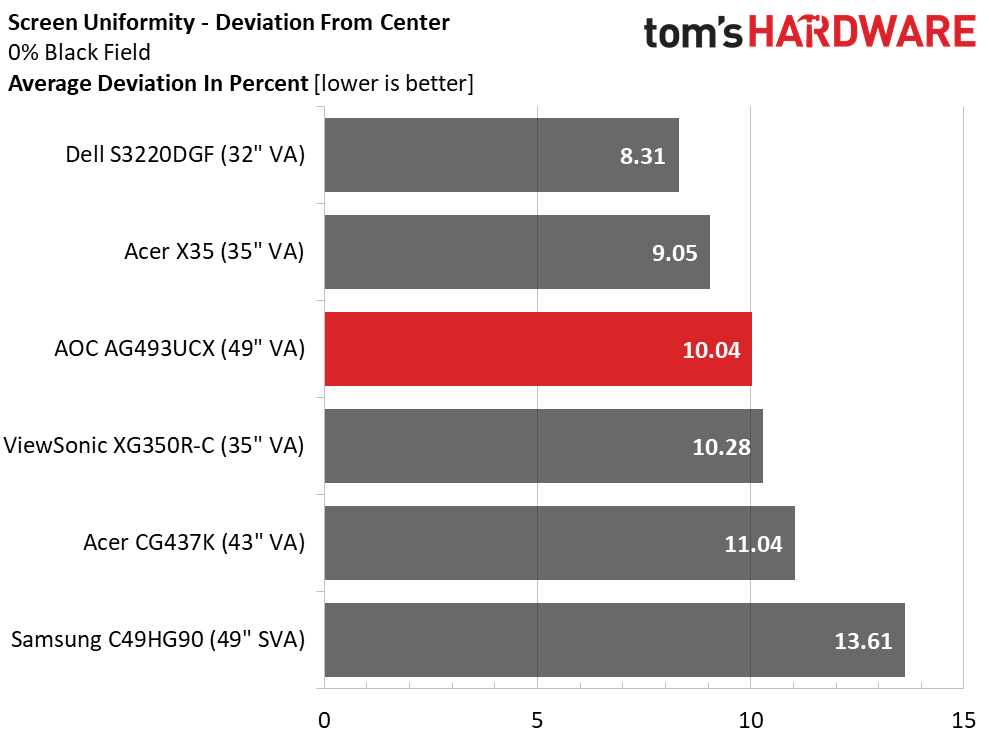Why you can trust Tom's Hardware
Viewing Angles
VA panels have continued to improve in their off-axis image quality, and the AG493UCX is a great example. Light falloff is only about 30% to the sides with a slight shift to red. The top-down view is excellent with a 20% brightness reduction, no obvious color shift and solid detail-rendering.
Screen Uniformity
To learn how we measure screen uniformity, click here.
Good screen uniformity is tough for ultra and mega-wide monitors to achieve. You can see that the Samsung is in last place, though its score of 13.61% deviation-from-center isn’t too bad. The AG493UCX does better at a respectable 10.04%. There was no visible hot-spotting, but our meter detected a little extra brightness in the upper corners. Our sample had no obvious bleed or glow issues, and images of all types looked smooth and uniform.
Pixel Response and Input Lag
Click here to read up on our pixel response and input lag testing procedures.


The AG493UCX’s screen draw time is as expected for a 120Hz monitor. With overdrive on, it rendered a full white frame in 8ms. You won’t need to use the motion blur reduction feature, which only reduced light output and took Adaptive-Sync out of the equation.
We also achieved predictable measurements in the input lag test. 34ms is about average for 120Hz screens, but surprisingly, the results do not rank by refresh rate. The CG437K is the fastest but tops out at 144Hz. But the X35 running at 200Hz only lags by 1ms, a paltry amount. These monitors are quick enough for all but the most highly-skilled gamers. We had no issues when playing our usual bevy of trigger-happy titles.
MORE: Best Gaming Monitors
Get Tom's Hardware's best news and in-depth reviews, straight to your inbox.
MORE: How We Test Monitors
MORE: All Monitor Content
Current page: Viewing Angles, Uniformity, Response and Lag
Prev Page HDR Performance Next Page Conclusion
Christian Eberle is a Contributing Editor for Tom's Hardware US. He's a veteran reviewer of A/V equipment, specializing in monitors. Christian began his obsession with tech when he built his first PC in 1991, a 286 running DOS 3.0 at a blazing 12MHz. In 2006, he undertook training from the Imaging Science Foundation in video calibration and testing and thus started a passion for precise imaging that persists to this day. He is also a professional musician with a degree from the New England Conservatory as a classical bassoonist which he used to good effect as a performer with the West Point Army Band from 1987 to 2013. He enjoys watching movies and listening to high-end audio in his custom-built home theater and can be seen riding trails near his home on a race-ready ICE VTX recumbent trike. Christian enjoys the endless summer in Florida where he lives with his wife and Chihuahua and plays with orchestras around the state.
-
JohnBonhamsGhost this thing is insanely wide, maybe too wide. though i would love to try it.Reply
how many games out there do you think would actually support 32:9? -
remosito Too wide for my tastes. Still waiting on a 5040x2160p 21:9 50incher with VRR and 120Hz HDR.Reply -
A Stoner Reply
I dunno, at 50 inches wide that would be a very tall monitor, you would get crane neck syndrome using it...remosito said:Too wide for my tastes. Still waiting on a 5040x2160p 21:9 50incher with VRR and 120Hz HDR. -
JohnBonhamsGhost Replyremosito said:Too wide for my tastes. Still waiting on a 5040x2160p 21:9 50incher with VRR and 120Hz HDR.
it can be a nice gaming solution but you need to be sitting quite a few feet away. had a 40.5" as my secondary gaming display for a year or two and it was nice with the Corsair Lapdog keyboard/mouse setup and my chair pushed back ~4'.A Stoner said:I dunno, at 50 inches wide that would be a very tall monitor, you would get crane neck syndrome using it... -
Ellimist This looks like its based off the samsung panel. The CRG90 which is 120hz same res but with quantum dot. Lets see a review of that. Its not really a replacement for the CHG90 like mentioned considering the Samsung CRG9 has been out for quite some time.Reply
The only downside to these is that you can't run 120hz and 10bit color. you max out at 100hz and 10bit if you don't want to use compression because of DP1.4. While its not a big downer I'm surprised you missed it in the negatives.
The next Samsung ultrawide the G9 solves all the problems with color and refresh because it uses DP2.0 so it has the bandwidth. the only thing I'm not sure about is the 1000R curve as I find the 1800R curve good for productivity use as well as gaming. i'm not sure if 1000R will meet my productivity needs or not. -
Brillis Wuce This product is DOA.Reply
Samsung CRG9 has the same specs, but with Quantum Dot and HDR1000.
It's marked up at the moment ($1287), but I've seen it drop down to $1100 on sale.
I'd gladly sacrifice the 10bit color for a full HDR1000. -
mac_angel I'm happy with my three Samsung RU8000 55" in surround mode. about 10' and 7680x1440@120Hz including HDRReply -
CharlesVee ReplyJohnBonhamsGhost said:this thing is insanely wide, maybe too wide. though i would love to try it.
how many games out there do you think would actually support 32:9?
Almost all current and last gen 3D games, 2D not so much, they're usually confined to 16:9. I was running a triple monitor surround setup all the way back in 2013, that's 7680x1440 and I got almost every game I played to run that way using simple tools like Flawless Widescreen, even the original Bioshock.
As for this monitor, it's very close to what I'm looking for, I'll probably end up buying either this or the Samsung equivalent. I don't want multiple monitors, I already sold the other two quite a while ago and now I'm suffering the productivity consequences of being confined to one screen! It's frustratingly constricting. The only thing I'd like is for it to be taller than a 27", same ratio just a few inches larger, but I don't think a monitor like that will be coming any time soon and I've already waited two years so I'm going to settle.

